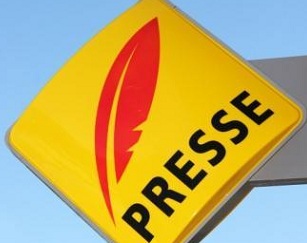La Tribune is trying to survive; France Soir is burying its paper edition; an economy plan within Les Echos... who will be next? And yet, France Soir originally functioned almost like a blog, in real time with its eight daily editions. So there are dead people, cripples trying to get out of it: big battles between traditional press groups and these new giants like Google, Apple, Amazon who are trying to establish new rules of the game. And yet there are still some diehards who are trying to shake up the way the French press (the free press) operates. Or even a few paper-loving fans against digital geeks: will they unleash a new generational war?
How to add value to information
For the past ten years or so, the written press has been faced with a crisis that has forced it to rethink its industrial and economic model. While specialised magazines and news weeklies have managed to maintain their circulation, this is not the case for the daily general news press, which is experiencing a decline in sales and advertising revenue. The proportion of French people declaring that they read a paid daily newspaper every day has been steadily declining: from 43 % in 1989 to 36 % in 1997 and then to 29 % in 2008. The reasons for this crisis are well known, but we are struggling to find the means to remedy it. The tremendous growth of the Internet has made it very easy to disseminate information, which Internet users have become accustomed to consuming free of charge.
Although steadily increasing, online advertising revenues are still far from compensating for the loss of revenue caused by the lower sales of printed newspapers. Numerous formulas have been experimented with with a view to creating an economic model. Turning their backs on the "all free" model originally envisaged, newspaper sites are now charging for an increasing proportion of their content. The market for touch-sensitive tablets appears to hold great promise for facilitating this payment.
Already sold 40 million copies, including more than a million in France (i.e. nearly 90 % of tablet sales), the iPad is above all considered as a media consumption tool: fully nomadic, permanent connection possibility, instinctive and playful handling, size adapted to reading, high visual quality, operating system allowing an infinite number of innovations...and a few fingertips are enough to buy a newspaper or a subscription. The point of sale has been brought as close as possible to the customer, right up to his bedside table.
Some important models
Anticipating a probable drop in the price of tablets, hundreds of newspapers and magazines from all countries have invested in the creation of multimedia versions specially adapted to the iPad. And newspapers designed exclusively for the iPad soon appeared. At the end of 2010, the Virgin Group launchedProject Magazine, a monthly "design, science, fashion and business" magazine, which sells for €3 per issue or €16 for the year. For Virgin, the challenge is to integrate sound and video, while maintaining a layout and look similar to that of a top-of-the-range paper magazine: the product should not look too much like a "classic" website, because in that case, readers, used to the free Internet, would probably be reluctant to pay. At the beginning of 2011, the Murdoch Group is also entering the "iPad newspaper" market with The Daily, a general daily newspaper with a large and well-illustrated "people" section. The subscription costs 1 dollar a week or 40 dollars a year. In November, The Daily had 120,000 readers per week, including 80,000 paying subscribers. According to figures published by Murdoch at the launch, it would need 500,000 to be profitable.
In their wake, many newspapers are inventing hybrid objects, based on the editorial content of their weekend supplements: a selection of redesigned and enriched articles, full-screen videos, 3D games and animations, interactive advertisements... Initially, these new weekend magazines are free. Other press media are considering solutions that combine paper and digital media, such as the solution SmartPaper invented and developed by SmartSystem. (Source : Yves Eudes / Le Monde Dec 2011)
What's at stake
However, the challenges of the digital press cannot be reduced to the economic dimension alone. The traditional reading of the paper newspaper gives way to a much more interactive relationship between the Internet user and the journalist, whose monopoly in the production of information seems to be called into question. Online newspapers must therefore reinvent themselves, innovate and find new assets to differentiate themselves and enhance the value of the information produced..
The French written press is currently going through a crisis. In addition to the decline in its circulation due to changes in lifestyles, there is also a drop in advertising revenue in a context of economic crisis and the development of a new digital offering. Indeed, technological change is not only upsetting the economic model of this medium, but also its organisation, business lines and content. The Estates General of the written press were organized in 2008, in order to "preserve one of the most precious assets of democracy: an independent, transparent and pluralist written press". However, the advent of digital technology should not only be seen as a threat to the survival of the press. It also represents a considerable opportunity for the development and reinvention of this sector in order to appeal to readers, especially the new generations. The speed of technological development and changes in usage is such that it is not easy to analyse the situation of the press in the face of the digital challenge. Are we moving towards a total dematerialization of the press medium? For Frédéric Filloux, CEO of Epresse, there is no other choice. He does not give an opinion on the date of the disappearance of the paper press in France - predicted for 2029 by an Anglo-Saxon consulting firm - but he does make the following observation: "For the coverage of hot news, paper no longer has any justification, it has become anachronistic. No matter what we do, news stories will completely switch to smartphones and tablets. "Does online news offer opportunities for open debate, or does it carry a high risk of concentrating opinions? Which business models seem to be the most suitable?
Recomposition of the print media landscape
In France, the development of online information precedes that of the Internet, since its origins go back to telematics and the minitel. In the 1980s, many French newspapers developed a version adapted to this medium, some even offering specialized services, such as the stock market monitoring service offered by Les Echos. A decade later, the growth of the Internet for the general public pushed the major media groups to invest in online press sites (for example, those of Libération and Le Monde appeared in 1995). The latter were then mainly content to transpose paper editions into digital format, with the exception of business newspapers, which quickly took the gamble on digital by offering specific editorial content. Gradually, all the generalist titles offered enriched web versions that very quickly found a wide audience. More recently, newspapers exclusively available on the Internet, the "pure players", such as Rue 89 and Mediapart, are emerging and often contain more varied and engaged articles than those of generalist news sites. Finally, smartphones and digital tablets are new media for online information, leading to the creation of dedicated applications.
This technological evolution has been coupled with a change in uses. Digital technology is now becoming part of the way of life for French newspaper readers. According to a study carried out by the GfK institute in association with Agence France-Presse, 42 % of the people interviewed said they had read articles offered by the digital press during the first three months of 2011. Thus, according to Médiamétrie, generalist news sites recorded an increase of 16 % in their daily audience in March 2011 compared to March 2010. Every day, nearly 6.6 million Internet users log on in France to consult the information on these news sites. When searching online, 79 % of digital readers favour the sites of national daily newspapers, far ahead of those of regional daily newspapers and magazines. This shift in usage is not, however, exclusive, since nearly half of digital readers continue to consult paper newspapers. However, the digital boom has two main impacts on the paper press. The first concerns consumers' trade-offs in terms of time: the arrival of this new medium effectively reduces the attention and time devoted to pre-existing ones. The second concerns the financial trade-off: consumers tend to favour the Internet, which is synonymous with free access.
The decline of the paper press
The erosion in sales of dailies and magazines is only partially offset by price increase strategies. In addition, advertisers, wishing to benefit from the widest possible audience, are redistributing their spending to the Internet, often to the detriment of the press. The decline in advertising revenues was particularly marked in 2009: - 17.6 % for national dailies, - 18.1 % for magazines and - 28.3 % for the free press. Operating expenses, for their part, remained very stable: both printing and paper costs varied only slightly over time given the incompressible printing costs and the rise in the price of paper pulp (+ 70 % between June 2009 and June 2011). In addition, the increasing irregularity of readings (with greater fluctuation depending on events) makes it difficult to adjust the number of copies delivered per point of sale (currently between 23,000 and 30,000 depending on the definition used). Groups are therefore forced to arbitrate between a reduction in the distribution base, which inevitably results in a loss of readership, or maintaining the base, with an increase in unsold copies.
It is therefore the industrial model of the paper press, based on economies of scale, that is now in great danger. The online press in fact leads to a reduction in production costs (it is estimated that switching to the web would save 35 % of these costs). The circuit between the writing of the article and its distribution is reduced to a minimum. The industrial phase disappears, which represents a significant saving in printing, paper and payroll costs. The elimination of physical distribution further minimizes costs, accelerates and enables distribution anytime, anywhere. Under such conditions, the managers of press organs could be tempted to take the wage bill as an adjustment variable. 13,500 journalist jobs were cut in the United States between 2007 and 2010. A vicious circle has thus gradually set in: the more money newspapers lose, the more they are tempted to reduce the size of their editorial staff, even if it means producing impoverished content that is less and less likely to be distinguishable from online news. The challenge is to produce quality information at a much lower cost than a traditional newsroom with its departments (politics, society, international affairs, culture, economics, etc.) and its high-level journalists capable of creating high value-added information including analysis, perspective and reporting.
What face for the press sector of tomorrow?
The French press is gradually switching to digital, but there is currently no stabilized model. It is in a phase of investment, experimentation and strategic positioning, but also of observation of consumer habits, which are largely determined by the quality and diversity of the offer. It is therefore difficult to extrapolate current usage to deduce future developments.
Two scenarios of evolution seem most likely: either the coexistence of the two media with the possibility of mutual reinforcement or, on the contrary, a reduction in their respective capacities depending on the differentiation strategies adopted and the choices made in terms of economic model; or the substitution of digital for paper media. Printed versions would gradually diminish with generational renewal (the "digital natives") and technological innovation. This scenario would be synonymous with a complete upheaval in the businesses and financial resources of press groups.
The upheaval of a profession
Online information and its faster and more fragmented way of consulting it than traditional print reading has forced newspapers to change the way they produce content. Web-based newsrooms have an obvious reactivity constraint: continuous information pushes editors to write short articles - 3,000 to 4,000 signs - incorporating very explicit terms so that the article is referenced as well as possible by search engines. This necessarily reduces the amount of time spent checking and correcting information. The Technologia report on the work of journalists reveals that 68 % journalists feel they have to work faster than before, suggesting that "verification, the cornerstone of journalists' professional pride, is still a widely respected requirement, but is increasingly hampered by the scarcity of time.
The challenge is to preserve what constitutes the core business of journalism while at the same time adapting the profession to the new imperatives of the digital age. To develop the profession without distorting it would undoubtedly imply an enrichment of initial and continuing training. There is a certain antagonism between print and web journalism, as new organizational patterns must be put in place. While the issues related to online information are increasingly integrated, much remains to be done in terms of computer skills. For example, Columbia University has just launched the first dual degree in journalism and web development to avoid the professional separation between form and content. Without going that far, the development of modules in computer engineering, computer graphics and data journalism in the initial training of journalists would help foster innovation.
(Source : Centre for Strategic Analysis Nov. 2011)
{Jacuzzi on}












